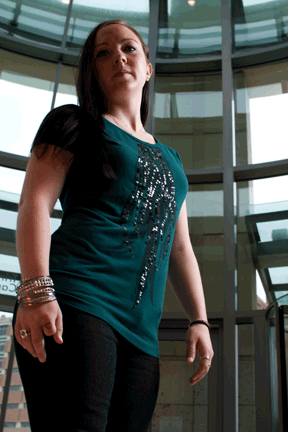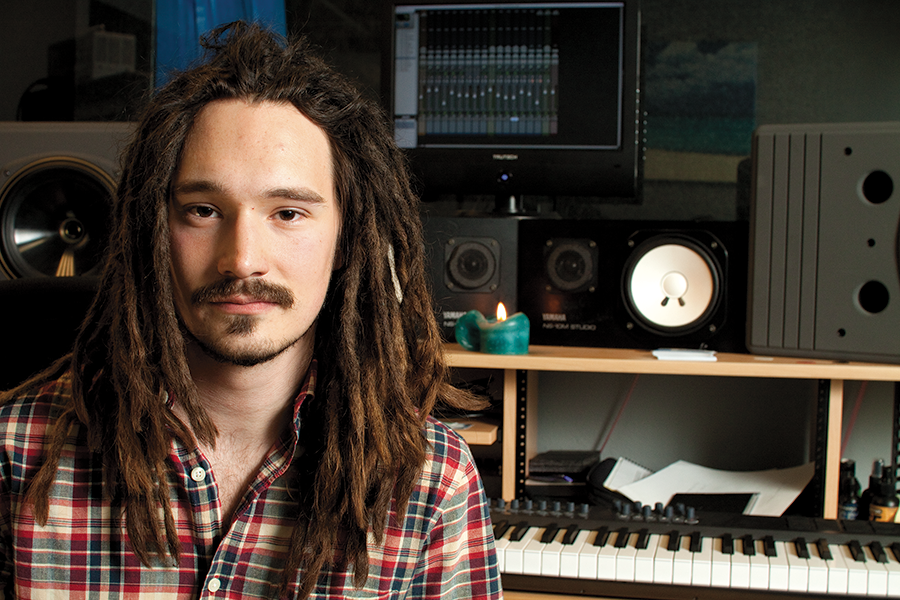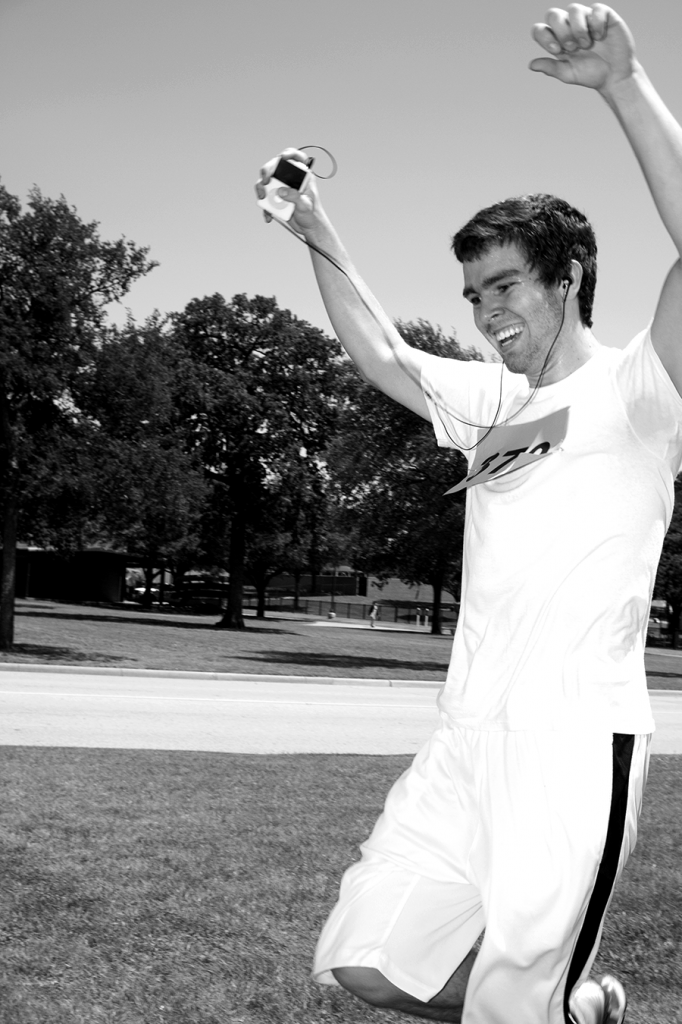By Amy Estrada/reporter

Casey Holder/The Collegian
Spending New Year’s Eve in Times Square with flashing lights and confetti filling the air would be the ideal way to start off any new year. But spending it watching the celebration on TV from a hospital bed would be far from anyone’s desire.
TR student Rachael Grunewald planned to see the ball drop on the streets in the middle of Times Square. Instead, she awoke New Year’s Eve not even knowing her name.
Grunewald was diagnosed with epilepsy on Dec. 31, 2009, when she experienced a grand mal seizure. Her mom awoke that morning to see her seizing, she said.
“When I came back to reality, I had no idea where I was, what my name was and why there were so many people around me [the paramedics],” she said. “All I could do was cry.”
During that day, she had two grand mal seizures. Grunewald called them “the big bang of seizures.”
She had experienced seizures for about five years prior to her diagnosis but never understood what was wrong. The seizures would happen while she was awake and in the middle of conversations.
“I guess I would space out but not sure how long,” she said. “When I came back from it, my mind was blank like a computer rebooting.”
Before being properly diagnosed, the plan was to admit herself into a mental institution. Grunewald was relieved to find out that she had epilepsy the day she went to the hospital. After finding out what had been going on for many years, she cried happy tears to know it was not a mental illness.
Now that she has been on medication, it is easier for her to tell when an epileptic episode is coming on and what she needs to do. They don’t happen often, but when they do, she said she is aware of what’s going on before and after.
It’s a day-by-day process, she said. She wakes up, takes her meds and thanks God she is still here.
“It’s hard being 21 and not being able to drink. The meds are so hard on your liver,” she said.
Epilepsy deals with the brain, which she said most people don’t think about. Since people can’t physically see the problem, she said it’s not taken as seriously.
The medicine Grunewald is prescribed causes her to be emotional. She said she can cry at the drop of a dime, and when she gets mad, she is really mad.
“The meds also make me feel stupid,” she said.
Knowledge she has gained from school is not easily retained. Friends will recall memories or stories, but she has no recollection of the events.
She is always tired, and when people don’t understand, it becomes difficult for her to express herself. She said she gets frustrated by it at times.
When explaining to her parents, it upsets her because they have no idea what is going on. She said it’s hard expressing herself when they don’t understand.
“They are so busy. They haven’t educated themselves about it,” she said.
When a person has a seizure, state law requires that person cannot drive until he or she has been seizure-free for six months, she said.
“My parents didn’t have time to take me anywhere, so I started driving after two months and lived on my own for five,” she said.
As much as she would like to be mad at her parents for not understanding epilepsy, she said she had to learn to take care of herself. Even though it would make it easier if they knew what was going on, she said she can’t change them. She can only change herself.
Grunewald wears a bracelet that has her name, her doctor’s name, her phone number and the fact she has epilepsy. The bracelet also lists what medication she is currently taking, so it helps the doctors to know what to do, she said.
“I wear it in case of an emergency, like a car wreck or I have another grand mal, where I don’t know what’s going on,” she said.
Every day gets better and better, and she’s learned to accept what’s going on and move forward.
“You can’t let it take control of your life,” she said.
According to the Epilepsy Foundation, one in 10 people will have a seizure during his or her lifetime. An estimated one-third of the 186,000 cases diagnosed each year occur during childhood.
TR student Kaitlin Hughes was found in a practice room the day she was diagnosed with epilepsy.
It was the fall of 2007, and Hughes was attending Ouachita Baptist University in Arkadelphia, Ark. She was in a practice room when her hands clamped shut and her arms and legs began to spasm.
“Imagine having muscle cramps, like a charley horse feeling, all over your body,” she said.
She was late for a meeting and attempted to send friends a text message of her whereabouts, but she said her hands were so stiff the text didn’t make any sense.
During a school break, she visited the doctor and was told she had a seizure disorder, she said. The doctor referred her to a neurologist who confirmed the diagnosis, she said.
Since her diagnosis, she has experienced on average about two to three seizures a week. It’s also a possibility she has had a couple while sleeping, she said.
After a seizure, she feels completely drained of energy, almost as if she just finished a really hard workout. Hughes uses an online seizure diary on epilepsy.com to keep track.
“It’s frustrating to say the least, but it is getting better one step at a time,” she said.
Two major triggers cause her seizures: flashing lights and a specific high-frequency sound wave. The most frustrating part for her, Hughes said, is not knowing what else can trigger her seizures.
Everything has become a little easier now that she has people she can talk to who know what she is going through, she said.
Explaining things became an issue because of the medication she was taking. One of the side effects was trouble with memory and word recall. Hughes said she tends to stumble in conversations.
A person with epilepsy has to avoid certain things. Hughes also mentioned the driving scenario as well.
“No driving for me. My last episode was March 29,” she said.
Movie theaters and video arcades are also out of the question because of flashing lights. Photosensitive epilepsy also deals with contrasts from light to dark, she said. She has to consider how fast a light or picture is moving, the size of a movie screen and how close one sits next to it.
“I tried going to a Dave & Buster’s for the first time with my boyfriend, and we got to the door and turned around because we saw all the lights,” she said.
Many people will have seizures and lose consciousness, but Hughes said she is fully awake and will have full conversations with someone during an episode.
She has full-blown seizures where she is on the ground and her entire body is shaking and clenching. She said it baffles her doctors that she can be awake and alert during a grand mal seizure.
Her seizures will last anywhere from 15-45 minutes, which is longer than usual. Most people will experience short seizures, she said.
During conversations, if the topic of epilepsy comes up, she said it bothers her when people say things like, “If anything happens, I know seizure first aid.” Comments like these she can go without hearing.
She said these comments make her feel like she isn’t normal. She knows she has epilepsy, and she doesn’t want anyone to think she can’t do things on her own.
Hughes also has a piece of jewelry — a necklace — she wears with her medical information on it like Grunewald.
“On the back of the pendant is my medical condition,” she said. “When someone calls the number, an operator picks up and gives the emergency staff all of my information in order to properly treat me.”
She also wears a capsule that has emergency pills in case she has an episode. The pill is used to calm her muscles because of the length of her seizures, she said.
She wants to be treated as normal because she is normal. She doesn’t need someone to take care of her, she said.
“I’m a big girl,” Hughes said. “Epilepsy doesn’t label a person as disabled. I hate being thought of as someone with ‘special needs.’ It’s not a big deal.”





























